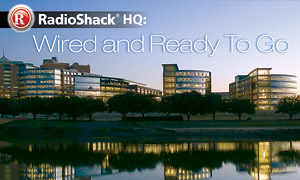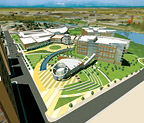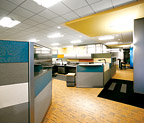
All photos were provided by HKS, Inc.
The new RadioShack headquarters in Fort Worth, TX is stunning on the outside and runs smoothly on the inside, thanks to its extensive HVAC controls and security system. The 900,000-square-foot World Headquarters Riverfront Campus, which is located on 31 acres on the south bank of the Trinity River, was officially dedicated in March. Approximately 2,400 RadioShack employees will work in the new campus, while enjoying amenities such as a cafeteria, coffee bar, fitness center, and convenience store.
The $200 million Riverfront Campus consists of three office buildings (approximately 200,000-sq-ft each), a commons building (300,000 sq ft), a 2,400-space parking garage, a broadcasting center, and a RadioShack showcase store called "StoreOne." All the buildings are attached by connector buildings. The unusual urban riverfront campus is at the hub of the proposed Trinity River Project downtown master plan, which includes a town lake and waterfront.
The Riverfront Campus had a very aggressive construction timetable, with only 22 months scheduled from start to finish. Considering that over 1,200 miles of wire needed to be installed for the BAS, card access, intercom, closed circuit television (CCTV), and fire alarm systems, it's amazing the facility was finished in such a short period of time.

Original Design
The Riverfront Campus is a unique development, and the architectural firm that designed the project relied on non-traditional construction methods in order to make sure their vision was achieved. Basically, the project started as more of a concept, rather than firm sets of specifications.To ensure that vendors were bidding "apples to apples," a preliminary set of drawings was created, and vendors were asked to bid on the listed quantities and also to give unit prices on additional work and equipment. This arrangement ensured that as the owners' requirements changed during construction, vendors couldn't overcharge for change orders.
Once vendors were awarded the job, they were designated as part of the design team. This meant that the contractors, engineers, and subcontractors worked together to determine if a particular design was going to work and, if not, what steps needed to be taken to make it work.
As such an integrated member of the design team, controls contractor Entech Sales and Service, Dallas, TX, had full input into the type of building automation and security systems the new building would need. Entech automation account executive Jim Hartman stated that his company was asked to install the "Continuum" BAS from Tour Andover Controls and security systems that included integrated access control, CCTV, digital video management, and intercom system.
"The mechanical engineer specified a BAS that utilized an open architecture, rather than a proprietary one, and the Continuum BACnet system is a 100% open protocol system," stated Hartman. "It was important for this system to have the capability to interface with third-party equipment such as the chillers, ModBus interface for the VFDs, computer room A/C units, and emergency power systems, as well as the Lutron lighting control system."
In addition, RadioShack's previous headquarters utilized an Andover "Infinity" control system, so the company was familiar with the system. "This helped in our decision to use Tour Andover Controls in the new facility. We also knew that Entech had the strength to meet our stringent construction requirements. Along with the mechanical and electrical contractors, they were active participants in the system design from the beginning of the project, and their willingness to work with RadioShack, the consulting engineer, and the general contractor added value to the installation and meeting the timelines of the project," said Ryan Montgomery, director of facilities for the RadioShack Corporation.

The HVAC System
The three office buildings have chilled water VAV AHUs with VFDs that serve two floors using an underfloor air distribution system. At over 550,000 sq ft, this is one of the largest underfloor air distribution systems in the state. Hartman stated that the underfloor system is beneficial, because it makes it easy to isolate floors that are unoccupied after hours, and it also significantly reduces the amount of ductwork needed.Fan-powered VAV boxes with electric reheat temper the air, and floor-mounted diffusers distribute the air throughout the floor. Tenants have the ability to adjust the floor-mounted diffusers if the airflow becomes a disturbance.
Outside air is regulated on each floor to meet ASHRAE standards by measuring the amount of CO2 in the spaces. "As the level of CO2 increases, more outside air is delivered to the air handling unit, while meeting rooms have occupancy sensors that shut down their VAV terminal units when the space is unoccupied," added Hartman.
CO2 monitoring and control were important components of the system, because the project was designed to achieve LEED® certification. To follow the green building concept, many environmentally friendly construction methods were utilized, and items such as low emission finishes for carpet and wall coverings and waterless urinals were installed. CO2 monitoring and control, including minimum outside air intake and exhaust, as well as demand control ventilation were required by the energy conservation codes.
The commons building and three connector buildings also have chilled water VAV AHUs with VFDs that serve above-ceiling fan-powered VAV boxes with electric reheat. These also have outside air that is controlled to maintain space CO2 conditions. The building also houses the RadioShack Operations Center (ROC), where all 5,000-plus retail stores are monitored 24/7 for data network integrity as well as point-of-sale information.
The RadioShack 10,000-sq-ft flagship store, StoreOne, is modeled after the ultimate modern home of the future. This unique retail environment is attached to the campus and utilizes the chilled water plant's air conditioning capabilities. StoreOne requires over 110 tons of CHW cooling, which is supplied by three AHUs. Card access, CCTV, and temperature monitoring via infrared radiant room temperature transmitters complete this installation.
The 40,000-sq-ft Circle R Media Broadcast Center, which leases space from RadioShack at the Riverfront Campus, is one of the largest of its kind in the state. The building features a floating floor, and all conduits, ducts, wireways, and pipework were acoustically isolated to eliminate noise transmission into the area. Ceiling-mounted VAV terminal units with electric reheat provide conditioned air to the center.
BAS and Security
BACnet HVAC controllers manage the campus-wide chilled water distribution system, air-handling system, and unitary equipment (terminal boxes, fancoil units, etc.). This includes five 700-ton chillers with variable primary flow via VFDs on the CHW pumps, five cooling towers, 100-plus air handling/fancoil units, over 1,050 fan-powered boxes, and almost 20,000 light fixtures. There are approximately 12,000 points associated with the BAS, including lighting.BACnet controllers communicate with Ethernet level CX9900 Netcontrollers via BACnet/IP. The Netcontrollers communicate over the customer's fiber optic LAN to a CYBERSTATION front-end computer system. In addition, a Web.Client interface is available for up to 10 concurrent users. This enables employees to access Web pages via their computer workstations over their network, allowing them to view temperatures, adjust setpoints, change time schedules, etc.
"We have software interfaces with the chillers, emergency power systems, computer room air conditioning units, and variable-frequency drives via ModBus," noted Hartman. "We also have an interface with the Lutron lighting controllers in one of the buildings." (Lutron was required in the broadcast center because of its dimming capabilities.)
The security portion of the job consists of card access, intercom, and CCTV with digital video recording. GE Infographic's "Diamond II" access control system utilizes over 150 proximity card readers interfacing with eight computer workstations and one "Nisca" badging workstation to print the company's logo and employee's picture with their name on the badge. Over 4,000 badges have been issued to date.
Emergency exit doors are monitored and alarmed if opened without proper verification through the card access system. If an intercom is triggered, a local camera will pan to the intercom through the use of presets, enabling the security officer to see who is activating the intercom.
The security system is integrated into the customer's LAN but is segmented from the BAS. The reason for this, noted Hartman, is that RadioShack has an extensive Intranet throughout their facility with a tremendous amount of redundancy. "It makes sense to have our system reside on that and let them maintain it, as opposed to putting a complete separate system out there."
The intercom system includes over 60 Code Blue stations that provide bidirectional communication throughout the facility to the security department to report emergencies, communicate alarms, and provide mustering stations during fire alarms or other emergencies. The CCTV system consists of over 130 Pelco cameras, using a digital video recording system by Nice Vision. Four terabytes of memory provide approximately 45 days of recording archives.
Combination fire/smoke dampers interface with both the fire alarm system as well as the BAS to ensure proper equipment shutdown including smoke control on fire alarm condition.

A Smooth Finish
Interoperability issues were few and far between, said Hartman, and Entech was able to use off-the-shelf drivers to interface the BAS with the chillers, computer room A/C units, emergency power systems, and the Lutron lighting control system. No custom software drivers were required, and the interface between the intercom and CCTV required no special programming or drivers.As with any job of this magnitude, there were a few problems that arose during start-up. But these primarily involved issues of interfacing with the customer's production network when the BAS was migrated over to their system, and these problems were resolved by working closely with RadioShack's IT department.
Getting the job finished on time was the biggest challenge to Hartman, who stated that it was definitely a "fast-paced job." One of the reasons for that was the fact that the project was well underway by the time the controls and security portions were put out to bid.
"That's pretty typical, but it would have been beneficial to start on the project a little earlier," said Hartman, who added that the buildings were already about 25% complete by the time Entech arrived on the scene. "For the first three weeks, we were scrambling to get conduit sleeves in place prior to pouring of the slabs. This entailed a substantial amount of overtime work that could have been eliminated if we had been brought in earlier."
Other than that, everything went smoothly. "This is probably the best job I've ever been involved in where people weren't coming and wanting to backcharge for every little thing. Normally, the different trades are coming and saying, ‘You cut my wire,' ‘You broke my glass,' and everyone backcharges each other. With this job, there was very little of that, which made it a much more enjoyable environment." ES

